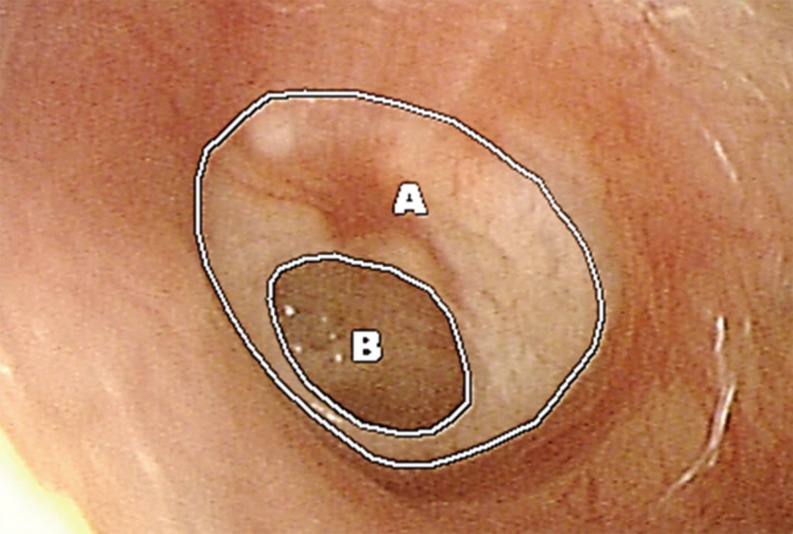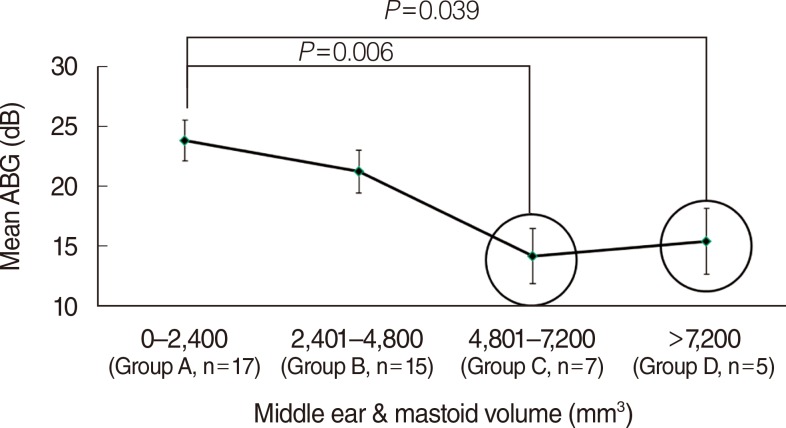Clin Exp Otorhinolaryngol.
2015 Jun;8(2):92-96. 10.3342/ceo.2015.8.2.92.
Determinants of Conductive Hearing Loss in Tympanic Membrane Perforation
- Affiliations
-
- 1Department of Otorhinolaryngology-Head and Neck Surgery, Seoul National University College of Medicine, Seoul, Korea. junlee@snu.ac.kr
- KMID: 2360777
- DOI: http://doi.org/10.3342/ceo.2015.8.2.92
Abstract
OBJECTIVES
Tympanic membrane perforations are common, but there have been few studies of the factors determining the extent of the resulting conductive hearing loss. The aims of this study were to determine whether the size of tympanic membrane perforation, pneumatization of middle ear & mastoid cavity, and location of perforation were correlated with air-bone gap (ABG) of patients.
METHODS
Forty-two patients who underwent tympanoplasty type I or myringoplasty were included and preoperative audiometry were analyzed. Digital image processing was applied in computed tomography for the estimation of middle ear & mastoid pneumatization volume and tympanic membrane photograph for the evaluation of perforation size and location.
RESULTS
Preoperative mean ABG increased with perforation size (P=0.018), and correlated inversely with the middle ear & mastoid volume (P=0.005). However, perforations in anterior versus posterior locations showed no significant differences in mean ABG (P=0.924).
CONCLUSION
The degree of conductive hearing loss resulting from a tympanic membrane perforation would be expected with the size of perforation and pneumatization of middle ear and mastoid.
MeSH Terms
Figure
Cited by 2 articles
-
The Dominance of Ossicular Route in Sound Transmission
Mohd Normani Zakaria, Aw Cheu Lih, Noor Alaudin Abdul Wahab
Clin Exp Otorhinolaryngol. 2016;9(3):282-283. doi: 10.21053/ceo.2015.01760.Butterfly Cartilage Tympanoplasty Long-term Results: Excellent Treatment Method in Small and Medium Sized Perforations
Isa Kaya, Murat Benzer, Mustafa Uslu, Cem Bilgen, Tayfun Kirazli
Clin Exp Otorhinolaryngol. 2018;11(1):23-29. doi: 10.21053/ceo.2017.00549.
Reference
-
1. Voss SE, Rosowski JJ, Merchant SN, Peake WT. How do tympanic-membrane perforations affect human middle-ear sound transmission? Acta Otolaryngol. 2001; 1. 121(2):169–173. PMID: 11349771.2. Voss SE, Rosowski JJ, Merchant SN, Peake WT. Middle-ear function with tympanic-membrane perforations. II. A simple model. J Acoust Soc Am. 2001; 9. 110(3 Pt 1):1445–1452. PMID: 11572355.
Article3. Voss SE, Rosowski JJ, Merchant SN, Peake WT. Middle-ear function with tympanic-membrane perforations. I. Measurements and mechanisms. J Acoust Soc Am. 2001; 9. 110(3 Pt 1):1432–1444. PMID: 11572354.
Article4. Mehta RP, Rosowski JJ, Voss SE, O'Neil E, Merchant SN. Determinants of hearing loss in perforations of the tympanic membrane. Otol Neurotol. 2006; 2. 27(2):136–143. PMID: 16436981.
Article5. Ibekwe TS, Nwaorgu OG, Ijaduola TG. Correlating the site of tympanic membrane perforation with Hearing loss. BMC Ear Nose Throat Disord. 2009; 1. 9:1. PMID: 19121227.
Article6. Ahmad SW, Ramani GV. Hearing loss in perforations of the tympanic membrane. J Laryngol Otol. 1979; 11. 93(11):1091–1098. PMID: 512477.
Article7. Bhusal CL, Guragain RP, Shrivastav RP. Size of typmanic membrane perforation and hearing loss. JNMA J Nepal Med Assoc. 2006; Jan-Mar. 45(161):167–172. PMID: 17160091.8. Mehmke S. Hearing loss in perforation of the tympanic membrane. Z Laryngol Rhinol Otol. 1962; 10. 41:677–682. PMID: 13934494.9. Pannu KK, Chadha S, Kumar D, Preeti . Evaluation of hearing loss in tympanic membrane perforation. Indian J Otolaryngol Head Neck Surg. 2011; 7. 63(3):208–213. PMID: 22754796.
Article10. Lindeman P, Holmquist J. Measurement of middle ear volume using the impedance audiometer. Am J Otol. 1981; 4. 2(4):301–303. PMID: 7258323.11. Rock EH. The physical volume test in impedance audiometry. Ear Nose Throat J. 1991; 4. 70(4):245–250. PMID: 1874157.12. Austin DF. On the function of the mastoid. Otolaryngol Clin North Am. 1977; 10. 10(3):541–547. PMID: 927842.
Article13. Bayramoglu I, Ardic FN, Kara CO, Ozuer MZ, Katircioglu O, Topuz B. Importance of mastoid pneumatization on secretory otitis media. Int J Pediatr Otorhinolaryngol. 1997; 5. 40(1):61–66. PMID: 9184979.14. Lee DH, Jun BC, Lee JH, Park SY, Lee DH, Yeo SW. Assessment of the mastoid pneumatization in unilateral chronic otitis media: Is the underdeveloped mastoid air cells a cause or a consequence of otitis media? Korean J Otolaryngol-Head Neck Surg. 2005; 6. 48(6):701–705.15. Lee DH, Jun BC, Kim DG, Jung MK, Yeo SW. Volume variation of mastoid pneumatization in different age groups: a study by three-dimensional reconstruction based on computed tomography images. Surg Radiol Anat. 2005; 3. 27(1):37–42. PMID: 15349696.
Article16. Tos M, Stangerup SE. The causes of asymmetry of the mastoid air cell system. Acta Otolaryngol. 1985; May-Jun. 99(5-6):564–570. PMID: 4024906.
Article17. Lee DH, Jun BC, Cho JE, Kim DG, Cho KJ, Yeo SW. Development of mastoid air cell system in Korean normal population: Three-dimensional reconstruction based on images from computed tomography. Korean J Otolaryngol-Head Neck Surg. 2004; 7. 47(7):612–616.18. Aoki K, Esaki S, Honda Y, Tos M. Effect of middle ear infection on pneumatization and growth of the mastoid process: an experimental study in pigs. Acta Otolaryngol. 1990; Nov-Dec. 110(5-6):399–409. PMID: 2284915.
Article
- Full Text Links
- Actions
-
Cited
- CITED
-
- Close
- Share
- Similar articles
-
- The Exploratory Tympanotomy in the Conductive Hearing Loss with Normal appearing Tympanic Membrane
- A Case of High Jugular Bulb Associated with Conductive Hearing Loss
- A Case of Unilateral Conductive Hearing Loss Treated with Stapedial Tenotomy
- A Case of Totally Lateralized Tympanic Membrane
- Two Cases of Pediatric Pneumolabyrinth with Traumatic Tympanic Membrane Perforation after Penetrating Injury






